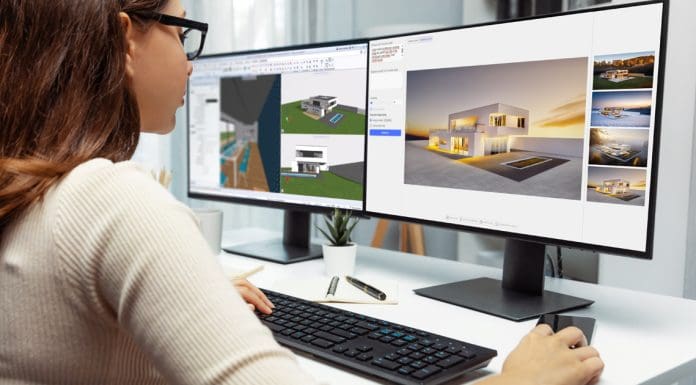
Stefan Kaufmann, product manager for BIM strategy & new technologies at Allplan, discusses how AI is enhancing design processes, improving efficiency and shaping the next generation of tools for the built environment
From streamlining workflows to sparking creative innovation, artificial intelligence is redefining what’s possible in architecture, engineering, and construction.
Where do you see AI making the biggest impact in the AEC industry right now, and what emerging applications hold the most promise?
Stefan Kaufmann: AI in AEC has evolved along two main tracks: broad, general-purpose AI like chatbots and image generators, and focused tools that solve specific tasks – like classifying point clouds or monitoring energy consumption. It’s been most effective where broad knowledge is needed or for replacing repetitive, low-value tasks.
AI is currently used in a wide range of applications, including text translations, building technology research and document management. There are also “Any2BIM” services, which convert data from drawings or point clouds into BIM models, significantly reducing the manual burden on design teams.
Generative pretrained AIs extract structured information from unstructured sources like PDF plans and use this to create knowledge graphs and link project data intelligently. We are continuously assessing multi-modal AI models to assist our customers in many areas – processing huge sets of 2D information can be optimised using groundbreaking technology such as this.
Most challenges in AEC are still too complex to be solved in one step by AI. Reasoning models are therefore a real game-changer for us. They analyse complex problems, break them down into manageable components and provide multistep solutions. They’re capable of working with large datasets to deliver advanced analysis, real-time decision-making and optimised workflows.
How is generative AI contributing to the early phases of design in the AEC industry?
Generative AI is useful for sparking early design ideas. Tools like Nemetschek’s AI Visualizer create images that let architects explore architectural styles and materials in seconds. The latest image generation models allow more precise restyling – for example, interactively adjusting façade materials or adding people.
We’re also seeing early tools that convert 2D inputs into 3D models. IFC prompting, for example, can create structured BIM data from a simple description – but still with limited architectural quality. AI can also assist with room book creation and understanding standards, helping shape design quality at an earlier stage.
How is AI influencing parametric and computational design?
The future lies in the convergence of statistical methods like machine learning and logical methods like parametric modelling.
There are two promising directions: first, generating agents from the parametric models that are adapted by the AI to the context in the building model; second, enabling AI to generate new parametric models from legacy or non-parametric CAD models.
However, I don’t believe we’ll see a general-purpose AI capable of handling the full design and engineering process autonomously at a human quality level within the next three years.

How is AI being used in conjunction with BIM?
AI is becoming a core part of BIM workflows. Conversational tools allow users to query BIM databases directly – for example, for extracting quantities or locating elements.
AI also helps map internal standards to project-specific requirements, currently a manual and error-prone process. Model enrichment is another area, along with automating drawing generation, which remains one of the most time-consuming tasks.
How can AI support sustainability and greener construction practices?
Delivering sustainable design is more time-consuming than complex. AI can streamline many of these tasks – like classifying building elements into material systems or proposing suitable material and construction solutions.
At the Georg Nemetschek Institute, we’re also researching how AI can support the AEC industry to become a circular economy. AI’s ability to process sensor data may help assess the structural health of concrete elements without destructive testing – which is useful for monitoring corrosion in steel reinforcement.
Are there any ethical and regulatory concerns the industry should be aware of?
Data privacy and intellectual property are key concerns when it comes to AI. Regulations help ensure that customer data is handled responsibly. At Allplan, for example, we’ve committed to not using customer data to train AI models and protect this under strict European laws.
Trust and transparency are essential. As AI becomes more embedded, clear ethical standards will be critical for building long-term confidence.
What challenges do AEC firms face when trying to implement AI?
Prioritisation is a major challenge – what seems innovative today could be replaced by another tool tomorrow. That’s why it’s crucial to focus on domain-specific solutions.
The other barrier is clean, structured data. Without it, even the best AI tools won’t deliver meaningful results. Data quality is everything.
What advice would you give to AEC firms just starting to explore AI?
The most valuable step right now is organising and consolidating data. AI tools are evolving rapidly but their effectiveness depends on the quality and structure of the data they’re using.
Make sure your project information is accessible, consistent and under your control. With this foundation, you’ll be ready to take advantage of the latest tools and innovations.
Finally, what excites you most about AI in the AEC industry?
We are currently experiencing the evolution of the most significant and far-reaching technological development in human history. Every week brings breakthroughs in AI that would have seemed impossible just a few months ago. Decades-old problems are now being solved with AI.
The real opportunity lies in making AI truly usable – transforming how we design and build, not in theory, but in CAX practice. The future of AEC is being shaped today.
The post How AI is shaping the future of AEC design appeared first on Planning, Building & Construction Today.

